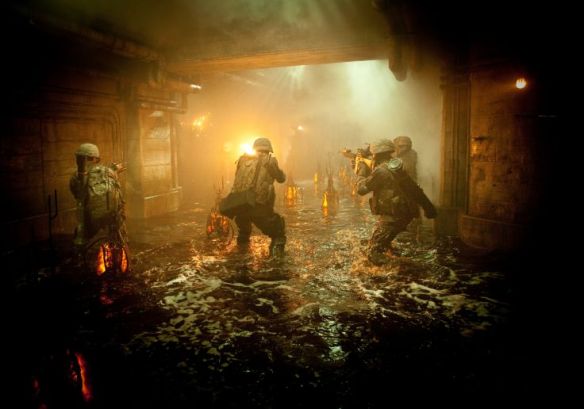
INTRODUCTION
Here’s how I think about the Traveller skill system:
I don’t really think of it as a skill system.
When I think about how Classic Traveller I see it less as a “skill system” as we often use such systems these days (REFEREE: “Oh, you want to try something? Make this roll…”) than I see it as the equivalent of a Saving Throw from OD&D.
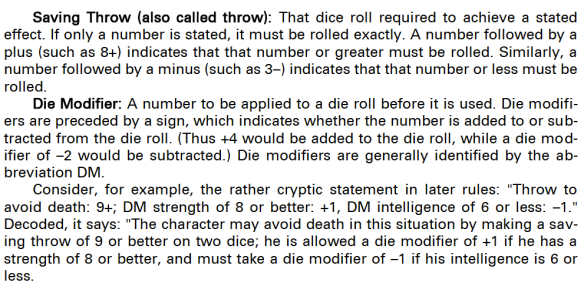
– Traveller Book 1
Characters and Combat (1977)
AN OLD WAY OF PLAYING
Sometimes we view the Classic Traveller rules through the lens of game design that came after it. In doing so, I think we do the game a disservice. We judge it for failing to work the way other games work, when in fact the game works very well to do what it was deigned to do, to play the way it was designed to be played.
The point of this post is to look at the rules of Classic Traveller in the context of the assumptions of the period the game was designed and played, and see what there is to find.
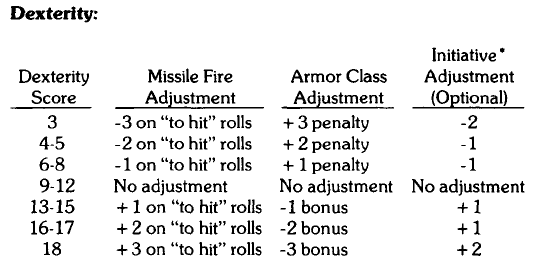
CHARACTERISTICS AS A SOURCE OF DIE MODIFIERS
The purpose of the Traveller: Out of the Box series is to explore what Traveller was designed to do, how it was meant to be used, and what kind of play it properly facilitated. In my view, Classic Traveller is best seen as growing out of the tradition and logic of Original Dungeons & Dragons. Marc Miller has been explicit about the connection. And Victor Raymond posted a series of smart observations from his time playing Classic Traveller in the late ’70s, illustrating the many ways Classic Traveller took direct inspiration from OD&D. In my view, if you’re playing Basic Traveller (that is Traveller Books 1-3, and not the materials that came later) then you’re playing in the tradition of play from the late 1970s and early ’80s, or the the revival of that style found in the contemporary Old School Renaissance.
In this spirit, let’s remember that in both original and B/X Dungeons and Dragons, there are no rolls made against Character Abilities. Yes, later editions of D&D introduced Characteristic rolls of d20 equal to or less than DEX and CHARISMA. But in the early versions of the games, these rolls don’t exist yet.
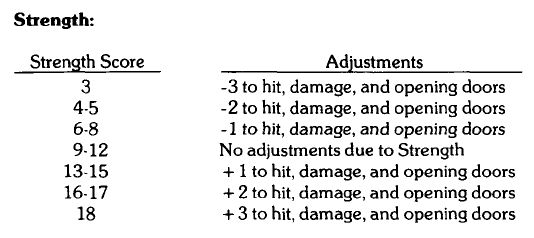
Instead, in early D&D, Character Abilities (Strength, Intelligence, Wisdom, Dexterity, Constitution, and Charisma) the Abilities themselves are never used in a roll. Instead, Abilities provide positive or negative modifiers (see images above) for specific rolls depending on their value. For example, if one has a Strength of 16 one gets a +2 to hit when attacking. But that value of 16 itself never is used in play except as that value might rise and fall through play (usually by magical means) which might then change the
Notice, now, that the same holds true for Basic Traveller. In rules in Books 1-3, there are no rolls made directly against the the Characteristics. (In The Traveller Adventure and other adventures, the Referee is told to have the Players roll 2D6 against a PC’s Characteristic or less. But that technique is not found in the original Traveller rules.)
Instead, we find the following…
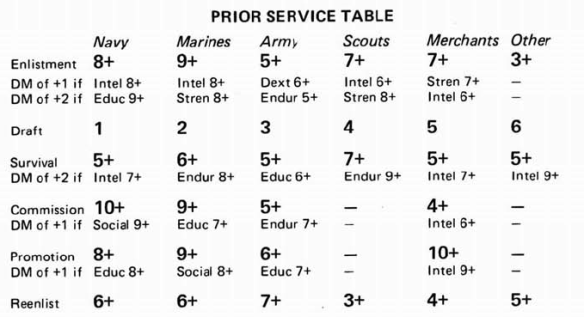
And we find this…
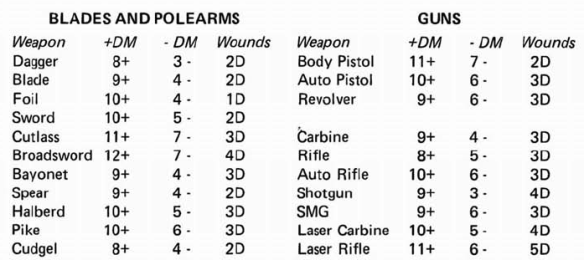
And we find this, specifically the last sentence…
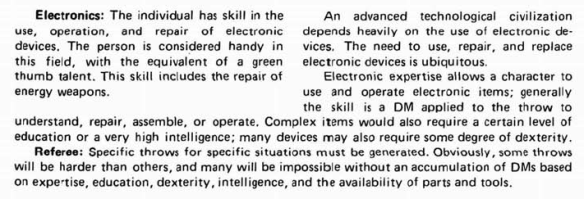
In original Traveller Characteristics work in exactly the same manner that Attributes in early Dungeons & Dragons worked: They are never used in resolving rolls in and of themselves, but, depending on their value, generate positive and negative modifiers for resolving rolls independent of them. Whether it is a modifier for getting in the Navy, or a modifier for shooting a weapon, or making a roll involving electronics.
So, for for the purpose of Classic Traveller play, let’s assume we never make Characteristics to see if someone can do something dexterous. Instead, let’s assume that if the Player gets his Player Character into a situation where a Saving Throw must be made to avoid things getting worse, the Referee will set a Saving Throw for 2D6, and if Dexterity is applicable, a -DM will apply if the PC’s Dexterity is a certain value or lower, and a +DM will apply if a PC’s Dexterity is a certain value or higher. Because in the rules, in every instance, this is how the game is written to be played.
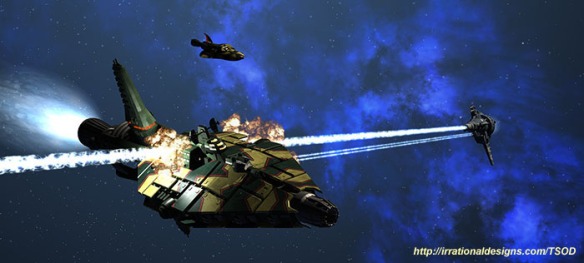
SAVING THROWS
I’ve been digging into the OSR (both for my interest in Classic Traveller and my the game of Lamentations of the Flame Princess campaign I’m currently running), and this meant digging into some really well written blogs. One of the most helpful sits was Hack & Slash. And, in particular, was this post on Saving Throws, which informs this very post you are reading on the Classic Traveller Skill System. Here was the key quote from the post:
The saving throw versus death, especially at low levels is a roll called for when the player has already made a poor choice that results in certain death. It is a chance to avoid death caused by a bad choice.
This was vital for me because it reinforced, in a practical manner, how these games were played. You poke and prod things fictionally (that is, through conversation between the Players and the Referee), building the world and the situation, until something involving danger happens. (See the quote at the top of this thread. Also, notice that this structure lines up with how Apocalypse World is built.)
If I ever get to run the Classic Traveller game I want to run, I’ll be treating the skills in that game exactly as Saving Throws as described in that quote. No one will be making a skill roll to see if they are competent in some way with their skill.
No pilot will ever be making a Pilot roll just to get out of a starport. Instead, we’ll be talking, building the fictional content. And if they’ve started something that introduces more trouble as they’re trying to get out of the starport, and then I respond with NPCs doing something in response to that, and then they do something else, and then that forces a new problem on them, and then they try to extricate themselves from the growing crisis with some sort of tricky piloting maneuver, then the Player makes a Saving Throw. If his Pilot skill can be applied, great. It it can’t, then it can’t. If Dexterity can be applied as a +/-DM, then it will be. If not, it won’t.
Thus, in how I’m talking about using there rules, there really is not such thing as a Pilot roll, or such a thing as a Dexterity roll. There are Saving Throws… and certain skills and and Characteristics can act as DMs to those rolls.
That is, as a Referee I just assume the PCs can just do things (or, if it makes no sense, can’t do things) until a crisis arrives. We just talk (Referee and Players) until their decisions or actions provoke some sort of danger or need that demands that they make a roll to avoidtrouble/danger/making the situation worse. And if they fail the roll, failed roll isn’t about flubbing the skill, necessarily, it is about the situation becoming worse.
That is, skills in my game most likely won’t be used to push forward but used when NPCs and the setting are pushing at the PCs.
Thus, Forgery skill doesn’t matter unless the forged document is passed off to an NPC who is the sort who would really look at it. A Pilot skill wouldn’t come into play unless something is already wrong with the ship or making a fancy, rare maneuver.
It’s a subtle difference, perhaps. But since the Referee must create the target number for the particular circumstance for the roll it seems to me that the circumstances for those rolls need to stand out in some particular way to make determine the circumstance worth that effort.
So, that’s how I see it:
The Skills are not used to “get things done.” They are not “Tasks.”
Instead, PCs are assumed to be competent at getting things done if they have the skill. Skills are used for a Throw when something is already going wrong.*
The same applies for Characteristics. If a relatively high intelligence is required to do something, then the Player Character can’t do things that require a thing that requires a high intelligence. Just roll the game along. If he doesn’t have the Intelligence to solve the problem one way, he will have to find another way. That’s how these games were designed to be played.
But if in a moment of crisis a Player Character requires a Saving Throw were Intelligence might come into a play, the Referee will set the Throw based on how difficult the situation is or isn’t, and then apply +/-DMs as he sees fit based on the PC’s Intelligence.
As for the DMs, I would look to the guidelines already presented in the Skill descriptions, and to the DMs offered for weapons to see what range of Characteristics tend to offer positive and minus DMS.
How does the Referee determine what is the Throw number? How does the Referee determine which Skills and Characteristics can provide DMs? And how much should those DMs be worth?
Well, first let me reiterate: Much of this is covered in the rules. The Referee should review the Skill descriptions and the DMs provided for combat and the enlistment tables. There is much to be gleaned from what is already in Traveller Books 1-3.
Second, the Referee is the final authority. The Referee is the final arbiter of these matters. But his decisions must both be and seem authoritative, impartial, and wise. If you’re ever making a decision a die roll to “get the Player Characters in trouble” or to “show them they’re making a bad decision” you’re doing it wrong. The only thing that should be guiding you is, “What seems reasonable here?”
Finally, the Referee should check in with the Players. The Players should always have a chance to make a case for DMs based on Skills or Characteristics. That is, the Player must describe how his or her PC is using a particular Skill or Characteristic. The Player should be specific. What is the image or action or detail that connects a Player Character’s Intelligence or Mechanic Skill with the Saving Throw at hand.
Not only does this provide interesting bits of descriptive detail to engage everyone the table, it helps build the world. We learn more about the character and how he or she solves problems. We learn more about about the world, and how the technology and societies work.
You’ll notice I’m telling a Referee to sort these things out in the moment, rather than offering hard and fast rules.
Exactly. That, I think, is how the game is meant to be played.

I think you’re right on about this. I’ve been doing a lot of OSR-style gaming the past year or two using a fantasy RPG system called Dungeon Crawl Classics. And it reiterates and important early D&D concept that many of us have forgotten. That is that if you’re a swordsman, you’re assumed to have a whole body of skills and knowledge around swords – manufacture, repair, history, etc. – not just how to hit something. So if your warrior PC is in town and needs to find a quality dealer, you just do it; you don’t roll dice. That’s like your example of a Traveller pilot doing normal pilot type stuff like a standard takeoff. Sadly, in the last CT campaign I ran for a couple years, I didn’t keep this in mind as much as I should’ve. But I think I’d do better now, especially after reading your post.
A brilliant analysis. This way of looking at CT skills makes so many things in the original rules make more sense. One of the things about CT I’ve always liked is that while character definitions revolve around their skills, the skill list isn’t the player’s “Play Book” of things their character is allowed to do. Casting skill throws as a form of saving throw really brings that to the foreground.
“One of the things about CT I’ve always liked is.. the skill list isn’t the player’s “Play Book” of things their character is allowed to do.”
Absolutely!
Lots of people think that you need a skill to be able to do it in Classic Traveller. But that’s not true. Player Characters can try most skills… just at a -DM penalty for some of them. The skill list a PC possesses is what he’s good at. But a PC can try to blunder his way forward on desperate rolls.
So, to bring this around back to D&D, this interpretation makes the thieve’s skills make more sense. You don’t roll to climb walls every time you climb, you roll when their is something at stake. For example, climbing a cliff to enter the evil overlords fortress is no roll, you roll when you are trying to climb back down while being chased by the overlords minions.
Similarly, the other classes without a thief’s skills can climb too. But, they are hosed if they try it in bad circumstances. They don’t get a save.
Yes. Exactly. That’s how I look at it.
For me, and this is only a recent observation after running my Lamentations of the Flame Princess game, the system is in place not to determine “What my guy knows” or “What my guy can do” but to resolve moments of crisis that come up in the game. The fact that one or more PCs might be better or worse at something doesn’t mean they can or cannot do something, or have no knowledge of the subject for every day use… it’s a matter adjustments to the odds when a crisis arrives.
I get it! After years upon years of gaming, I now get how I (maybe not everyone, but certainly *I*) ought to referee RPGs with skill systems.
http://drbargle.blogspot.fr/2016/03/skills-as-saving-throws.html
Fantastic article. I will be using DMs in just that way next time I play Traveller ’77. Your series of articles has made me dig out the little black box and I really want to play it.
Pingback: Wild Hunt Studios » Blog Archive » You Only Roll When…
Pingback: Tales to Astound!
Pingback: Traveller’s Low Berth – THE CGA